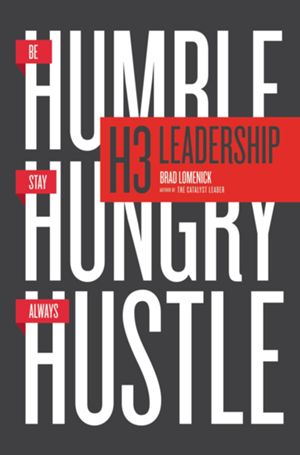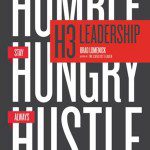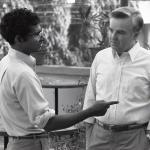I am privileged to host a 3-part Q & A series with my friend Brad Lomenick on his new book H3 Leadership: Be Humble. Stay Hungry. Always Hustle. Brad is a leadership consultant, speaker, founder of BLINC, and author of The Catalyst Leader — and a really terrific guy who practices what he preaches.
As the former president and key visionary of Catalyst, he learned a lot about leadership and reveals a lot in this book about how God prepared him for this next phase of growth he’s presently experiencing.
How is H3 Leadership different than your first book, The Catalyst Leader?
My first book, The Catalyst Leader, was a big picture, destination book providing essentials for leadership for the next 30 years. A foundation book you might say. If you think of it in terms of an organization, The Catalyst Leader was the corporate and staff handbook.
H3 Leadership is more of a playbook of discipline that will help get you to the finish line. A practical application, daily practice, process, routine and “on the journey” book that can and should immediately transform the way you lead. What leadership looks like on a day-to-day basis. The organization playbook, daily map and gameplan focused on daily practice and discipline that will make your leadership come alive.
The Catalyst Leader provided the key essentials and H3 Leadership provides the key habits. Essentials are what you become, and habits are how you become the leader you desire to be.
H3 describes the “ready” leadership position. I played basketball growing up, and I remember many coaches talking about the ready position in basketball. The posture from which you can dribble, pass, or shoot. I believe that H3 Leadership describes the ready leadership position — the triple threat posture of a properly prepared leader:
- Humble is internal leadership. Hearts.
- Hungry is external leadership. Head.
- Hustle is expression and extension leadership. Hands.
The phrase “humble, hungry, hustle” is my life and leadership mantra. If he had to describe his leadership style in 3 words, these would be it. So much of what I have worked for and want to see in the next generation is a combination of these three transformational habits. Humble, hungry and hustle describes the leader who realizes it’s not about them, is willing to work hard, and ultimately get it done. H3 Leaders know that influence is about developing the right habits for success.
H3 is practical. In the trenches, a bit chaotic, organic and dirty handed leadership. The dirt under your fingernails kind of leadership learned from digging the ditch, focused on the discipline, process, practice and journey of becoming a better leader.
The everyday habits, not necessarily the sexy sizzle. The broccoli and vegetables, not necessarily the steak. Not always pretty but hopefully constantly practical. I’ve tried to be practical at every level. Combining experience and wisdom and practical from the trenches. From my story and the story of others. Put your hardhat on and let’s get to work!
Why a book about leadership habits?
Brad: Because it’s very easy for us to flame out. We start strong as leaders, but many times don’t finish strong. And lose momentum and then not finish well. This is why leadership habits are so important.
Habits will allow you to sustain and finish well. Habits put discipline in place- daily discipline and a system that hopefully is second nature like brushing your teeth.
You will never change your life and truly become a change maker until you change your habits. Until you change your normal, daily routine. The secret of your success is found in your daily routine. The habits you’ve formed and continue to form. What becomes second hand and internal. Leadership comes down to the practical, the everyday, the blocking and tackling.
The components that are not sexy to talk about or don’t wow a crowd at the latest leadership conference or inspirational gathering. But more the stuff that no one really wants to pay attention to. That is where the essence of your leadership journey begins. In the mundane everyday systematic pace and process and routine of life.
In the same way that you lose weight by creating new habits, and you quit smoking by creating new habits, and you improve your attitude by creating new habits, so it goes with your leadership. You will influence better and truly be a transformative leader once you establish leadership habits in your life that create a sustainable and formidable system that will put your leadership into action.
Change what you do daily and you will change what you do weekly, and monthly, and yearly, and for a lifetime. Transformation happens because of habits, key elements and essentials becoming second hand, part of your normal routine and actions.
Goals lead to behavior, which leads to practice, which leads to habits, which lead to change, which leads to health. How you approach your day is how you will ultimately live your life. Daily habits lead to yearly transformation, which leads to lifetime influence and impact.
You’re very open and honest about how you’ve led, especially at Catalyst. Why did you decide to be so candid about what you feel like you did wrong?
Brad: It was important to me to shoot really straight in this book. The very nature of this book required a bit more transparency. But I would also say that I believe the leaders who will have the most influence and impact are the ones who are willing to be vulnerable and talk openly about their struggles and failures.
And that’s a hard thing for a lot of leaders to do. Many times, when we get to a point where other people are listening to us, and we’ve got something to manage––something to lose––we sort of go into the default mode of “Okay, make sure everything looks perfect.”
Today, people crave authenticity. This need has even influenced the way we shop and purchase our products from organizations. Today, customers buy from those we feel are trustworthy. Equally, we want to invest in people and companies that we can trust, not necessarily because they’re well known or largest or leaders in their industry.
Really, the first couple of chapters of the book are about defining and setting this foundation of “Man, you’ve got to be willing to be real with people around you if you want them to follow you.”
So often, leadership, especially self-help leadership and personal growth literature, can feel very pie in the sky––very esoteric. You’re philosophizing constantly.
Readers need a practical example that they can wrap their arms around––actually feel and see and experience the very specific thing that somebody has gone through. It’s one thing to tell others to be willing to share struggles and to talk about failures. It’s another thing to say, “Here’s what I’ve failed at.”
But the leaders I respect the most are the ones who continue to run the race well until the gun goes off, whether that’s because their life is over or they retire. That’s the posture of hungry: the idea that you constantly are learning and getting better. That’s the kind of leader I want to be. I think that’s the kind of leaders we need today.
I think it’s important for people to realize this is an ongoing journey.
Continue to Part 3
















